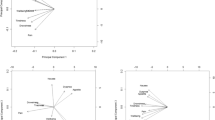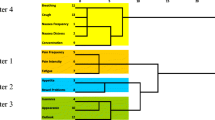Abstract
Goals of work
It has been observed that certain cancer symptoms frequently occur together. Prior research on symptom patterns has focused mainly on inpatients, early stage cancers, or a single cancer type or metastatic site. Our aim was to explore symptom clusters among outpatients with different advanced cancers.
Materials and methods
Symptom scores by the Edmonton Symptom Assessment Scale (ESAS) were routinely collected for patients attending the Oncology Palliative Care Clinics at Princess Margaret Hospital from January 2005 to October 2007. Principal component analysis (PCA) was performed for the entire patient cohort and within specific disease sites to determine inter-relationships of the nine ESAS symptoms.
Main results
A total of 1,366 patients was included: 682 (50%) were male and 684 (50%) were female. The median age was 64 years (range 18 to 74 years). The most common primary cancer sites were gastrointestinal (27%), lung (14%), and breast (11%). The three most distressful symptoms were fatigue, poor general well-being, and decreased appetite. PCA of symptoms for the entire patient cohort revealed two major symptom clusters: cluster 1 included fatigue, drowsiness, nausea, decreased appetite, and dyspnea, which accounted for 45% of the total variance; cluster 2 included anxiety and depression, which accounted for 10% of the total variance. There was high internal reliability in the clusters (Cronbach’s alpha coefficient ∼0.80). PCA of symptoms within the various primary cancer sites revealed differences in the pattern of symptom clusters.
Conclusions
In patients with advanced cancers, distinct symptom clusters can be identified, which are influenced by primary cancer site. Treatments directed at symptom clusters rather than individual symptoms may provide greater therapeutic benefit. Further prospective studies are warranted in order to develop more effective targeted palliative interventions for the advanced cancer patient population.
Similar content being viewed by others
References
Argiles JM, Busquets S, Garcia-Martinez C, Lopez-Soriano FJ (2005) Mediators involved in the cancer anorexia–cachexia syndrome: past, present, and future. Nutrition 21:977–985
Barsevick AM, Whitmer K, Nail LM, Beck SL, Dudley WN (2006) Symptom cluster research: conceptual, design, measurement, and analysis issues. J Pain Symptom Manage 31:85–95 doi:10.1016/j.jpainsymman.2005.05.015
Bender CM, Ergyn FS, Rosenzweig MQ, Cohen SM, Sereika SM (2005) Symptom clusters in breast cancer across 3 phases of the disease. Cancer Nurs 28:219–225 doi:10.1097/00002820-200505000-00011
Bruera E, Kuehn N, Miller MJ, Selmser P, Macmillan K (1991) The Edmonton symptom assessment system (ESAS): a simple method for the assessment of palliative care patients. J Palliat Care 7:6–9
Bruera E, Michaud M, Vigano A et al (2001) Multidisciplinary symptom control clinic in a cancer center: a retrospective study. Support Care Cancer 9:162–168 doi:10.1007/s005200000172
Chang VT, Hwang SS, Feuerman M (2000) Validation of the Edmonton symptom assessment scale. Cancer 88:2164–2171 doi:10.1002/(SICI)1097-0142(20000501)88:9<2164::AID-CNCR24>3.0.CO;2-5
Chang VT, Hwang SS, Feuerman M, Kasimis BS (2000) Symptom and quality of life survey of medical oncology patients at a veteran affairs medical centre. Cancer 88:1175–1183 doi:10.1002/(SICI)1097-0142(20000301)88:5<1175::AID-CNCR30>3.0.CO;2-N
Chen ML, Tseng HC (2006) Symptom clusters in cancer patients. Support Care Cancer 14:825–830 doi:10.1007/s00520-006-0019-8
Cheung WY, Barmala N, Zarinehbaf S, Rodin G, Le LW, Zimmermann C (2008) The association of physical and psychological symptom burden with time to death among palliative cancer outpatients. J Pain Symptom Manage. doi:10.1016/j.jpainsymman.2008.03.008
Chow E, Davis L, Holden L, Tsao M, Danjoux C (2005) Prospective assessment of patient-rated symptoms following whole brain radiotherapy for brain metastases. J Pain Symptom Manage 30:18–23 doi:10.1016/j.jpainsymman.2005.02.009
Chow E, Fan G, Hadi S, Filipczak L (2007) Symptom clusters in cancer patients with bone metastases. Support Care Cancer 15:1035–1043 doi:10.1007/s00520-007-0241-z
Chow E, Fan G, Hadi S, Wong J, Kirou-Mauro A, Filipczak L (2008) Symptom clusters in cancer patients with brain metastases. Clin Oncol (R Coll Radiol) 20:76–82 doi:10.1016/j.clon.2007.09.007
Cleeland CS, Mendoza TR, Wang XS et al (2000) Assessing symptom distress in cancer patients: the MD Anderson symptom inventory. Cancer 89:1634–1646 doi:10.1002/1097-0142(20001001)89:7<1634::AID-CNCR29>3.0.CO;2-V
Dodd MJ, Miaskowski C, Paul SM (2001) Symptom clusters and their effect on the functional status of patients with cancer. Oncol Nurs Forum 28:465–470
Dudgeon D, Vaitonis V, Seow H et al (2007) Ontario, Canada: using networks to integrate palliative care province-wide. J Pain Symptom Manage 33:640–644 doi:10.1016/j.jpainsymman.2007.02.001
Faithfull S, Brada M (1998) Somnolence syndrome in adults following cranial irradiation for primary brain tumours. Clin Oncol (R Coll Radiol) 10:250–254 doi:10.1016/S0936-6555(98)80011-3
Fan G, Filipczak L, Chow E (2007) Symptom clusters in cancer patients: a review of the literature. Curr Oncol 14:173–179 doi:10.3747/co.2007.145
Fan G, Hadi S, Chow E (2007) Symptom clusters in patients with advanced-stage cancer referred for palliative radiation therapy in an outpatient setting. Support Cancer Ther 4:157–162 doi:10.3816/SCT.2007.n.010
Gift AG, Jablonski A, Stommel M, Given CW (2004) Symptom clusters in elderly patients with lung cancer. Oncol Nurs Forum 31:202–212 doi:10.1188/04.ONF.203-212
Glaus A, Boehme CH, Thurlimann B (2006) Fatigue and menopausal symptoms in women with breast cancer undergoing hormonal cancer treatment. Ann Oncol 17:801–806 doi:10.1093/annonc/mdl030
Hadi S, Fan G, Hird AE, Kirou-Mauro A, Filipczak LA, Chow E (2008) Symptom clusters in patients with cancer with metastatic bone pain. J Palliat Med 11:591–600 doi:10.1089/jpm.2007.0145
Hoschl C, Svestka J (2008) Escitalopram for the treatment of major depression and anxiety disorders. Expert Review of Neurotherapeutics 8:537–552 doi:10.1586/14737175.8.4.537
Ivanova MO, Ionova TI, Kalyadina SA et al (2005) Cancer-related symptom assessment in Russia: validation and utility of the Russian MD Anderson symptom inventory. J Pain Symptom Manage 30:443–453 doi:10.1016/j.jpainsymman.2005.04.015
Jordhoy MS, Kaasa S, Fayers P et al (1999) Challenges in palliative care research; recruitment, attrition and compliance: experience from a randomized controlled trial. Palliat Med 13:299–310 doi:10.1191/026921699668963873
Kayacan O, Karnak D, Beder S et al (2006) Impact of TNF-alpha and IL-6 levels on development of cachexia in newly diagnosed NSCLC patients. Am J Clin Oncol 29:328–335 doi:10.1097/01.coc.0000221300.72657.e0
Kim HJ, McGuire DB, Tulman L, Barsevick AM (2005) Symptom clusters: concept analysis and clinical implications for cancer nursing. Cancer Nurs 28:270–284
Lidstone V, Butters E, Seed PT, Sinnott C, Beynon T, Richards M (2003) Symptoms and concerns amongst cancer outpatients: identifying the need for specialist palliative care. Palliat Med 17:588–595 doi:10.1191/0269216303pm814oa
Mercadante S, Villari P, Ferrera P, Casuccio A (2006) Opioid-induced or pain relief-induced symptoms in advanced cancer patients? Eur J Pain 10:153–159 doi:10.1016/j.ejpain.2005.02.006
Miaskowski C, Aouizerat BE, Dodd M, Cooper B (2007) Conceptual issues in symptom clusters research and their implications for quality-of-life assessment in patients with cancer. J Natl Cancer Inst Monogr 37:39–46 doi:10.1093/jncimonographs/lgm003
Okuyama T, Wang XS, Akechi T et al (2003) Japanese version of the MD Anderson symptom inventory: a validation study. J Pain Symptom Manage 26:1093–1104 doi:10.1016/j.jpainsymman.2003.05.003
Portenoy RK, Thaler HT, Kornblith AB (1994) Symptom prevalence, characteristics, and distress in a cancer population. Qual Life Res 3:183–189 doi:10.1007/BF00435383
Potter J, Hami F, Bryan T, Quigley C (2003) Symptoms in 400 patients referred to palliative care services: prevalence and patterns. Palliat Med 17:310–314 doi:10.1191/0269216303pm760oa
Ridner SH (2005) Quality of life and a symptom cluster associated with breast cancer treatment-related lymphedema. Support Care Cancer 13:904–911 doi:10.1007/s00520-005-0810-y
Romito F, Montanaro R, Corvasce C et al (2008) Is cancer-related fatigue more strongly correlated to haematological or to psychological factors in cancer patients? Support Care Cancer 16:943–946 doi:10.1007/s00520-007-0357-1
Sarna L, Brecht ML (1997) Dimensions of symptom distress in women with advanced lung cancer: a factor analysis. Heart Lung 26:23–30 doi:10.1016/S0147-9563(97)90006-6
Smith JR, Glaspy JA, Tchekmedyian NS et al (2003) Hemoglobin increase is associated with improved health-related quality of life in patients with cancer not receiving chemotherapy. Support Cancer Ther 1:49–54 doi:10.3816/SCT.2003.n.004
Stromgren AS, Goldschmidt D, Groenvold M et al (2002) Self-assessment in cancer patients referred to palliative care: a study of feasibility and symptom epidemiology. Cancer 94:512–520 doi:10.1002/cncr.10222
Stromgren AS, Sjogren P, Goldschmidt D et al (2005) A longitudinal study of palliative care: patient-evaluated outcome and impact of attrition. Cancer 103:1747–1755 doi:10.1002/cncr.20958
Walsh D, Rybicki L (2006) Symptom clustering in advanced cancer. Support Care Cancer 14:831–836 doi:10.1007/s00520-005-0899-z
Wang XS, Laudico AV, Guo H et al (2006) Filipino version of the MD Anderson Symptom Inventory: validation and multisymptom measurement in cancer patients. J Pain Symptom Manage 31:542–552 doi:10.1016/j.jpainsymman.2005.11.011
Wang XS, Wang Y, Guo H, Mendoza TR, Hao XS, Cleeland CS (2004) Chinese version of the MD Anderson symptom inventory: validation and application of symptom measurement in cancer patients. Cancer 101:1890–1901 doi:10.1002/cncr.20448
Zimmermann C, Seccareccia D, Clarke A, Warr D, Rodin G (2006) Bringing palliative care to a Canadian cancer center: the palliative care program at Princess Margaret Hospital. Support Care Cancer 14:982–987 doi:10.1007/s00520-006-0093-y
Author information
Authors and Affiliations
Corresponding author
Rights and permissions
About this article
Cite this article
Cheung, W.Y., Le, L.W. & Zimmermann, C. Symptom clusters in patients with advanced cancers. Support Care Cancer 17, 1223–1230 (2009). https://doi.org/10.1007/s00520-009-0577-7
Received:
Accepted:
Published:
Issue Date:
DOI: https://doi.org/10.1007/s00520-009-0577-7




